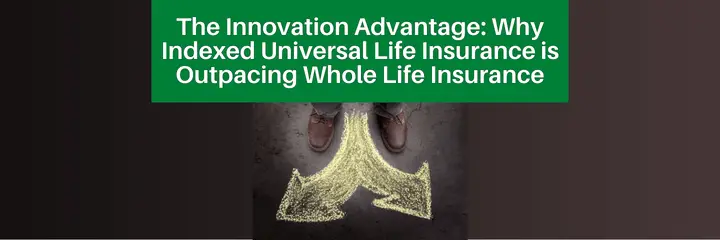Podcast: Play in new window | Download
The world of life insurance is an ever-evolving landscape, and as a result, new products and strategies continue to emerge. Among them, indexed universal life insurance (IUL) has been garnering attention for its unique approach to cash value accumulation and premium flexibility. In this article, we'll delve into the reasons why IUL is outpacing whole life insurance (WL) in terms of innovation while still acknowledging the valuable role that whole life insurance plays for many policyholders.
A Tale of Two Insurance Products: Permanent Coverage with a Twist
Both IUL and WL fall under the umbrella of permanent life insurance, meaning they provide coverage for the policyholder's entire life as long as premiums are paid. They also both offer a cash value component that grows on a tax-deferred basis. However, that's where the similarities end, and the innovation advantage of IUL begins to shine.
Cash Value Accumulation: Equity Index Participation vs. Dividend Paying
 One of the main differentiators between IUL and WL is how the cash value within the policy grows. With WL, the cash value grows at a guaranteed interest rate plus any potential dividends the insurance company pays. These dividends are not guaranteed and are typically paid to participating policyholders.
One of the main differentiators between IUL and WL is how the cash value within the policy grows. With WL, the cash value grows at a guaranteed interest rate plus any potential dividends the insurance company pays. These dividends are not guaranteed and are typically paid to participating policyholders.
On the other hand, IUL offers a more innovative approach to cash value accumulation by linking the growth to the performance of a specified equity index, such as the S&P 500. This allows policyholders to benefit from market gains while being protected from market downturns with a guaranteed minimum interest rate (1% or 0% in most cases). This equity index participation enables IUL policyholders to achieve higher returns compared to the fixed interest rates and non-guaranteed dividends offered by WL policies.
Premium Flexibility: Adapting to Life's Changes
Another area where IUL outshines WL is premium flexibility. With WL, policyholders are required to pay fixed premiums throughout the life of the policy. However, IUL offers adjustable premiums, allowing policyholders to increase or decrease their payments based on their financial situation within certain limits. This flexibility can be crucial during times of financial uncertainty or when other priorities emerge.
Policy Lapse Protection: Keeping Coverage in Place
IUL policies often include a no-lapse guarantee, ensuring that as long as a minimum premium is paid, the policy will remain in force during the guaranteed period (often 20-30 years), even if the cash value is insufficient to cover the cost of insurance. This policy lapse protection offers a layer of security for policyholders, ensuring their coverage remains in place.
Weighing the Risks: Investment Risk and Policy Loans
While IUL offers several advantages over WL, it's essential to understand the associated risks. One such risk is the investment risk tied to equity index participation. Although IUL policies have a guaranteed minimum interest rate, the non-guaranteed interest portion is subject to market fluctuations. This means that if the equity index performs poorly, the cash value growth may be lower than anticipated.
Another consideration is policy loans. Both IUL and WL policies allow for policy loans, providing policyholders access to their cash value on a tax-free basis. However, policy loans come with the possibility that unpaid loans may reduce the death benefit or cause the policy to lapse. It's crucial for policyholders to carefully evaluate their needs and the potential consequences before taking out a policy loan and to manage the effects of the loan as they move through time.
Surrender Charges and Withdrawal Options: Accessing Your Cash Value
IUL policies can have surrender charges, which are fees assessed if the policyholder decides to cancel or “surrender” their policy during a specified period, typically the first several years of the policy. However, there are still options for accessing cash value without incurring surrender charges.
WL policies do not typically have surrender charges for a full surrender or a policy cancellation. However, depending on when and how much of a withdrawal you would like to take, the cash value you have available for surrender may be significantly lower than the total premiums paid. This is technically not a surrender charge, but it is the same mechanically because you are getting less money than you paid.
Partial surrenders, for example, allow policyholders to withdraw a portion of their cash value without canceling the policy. This can be particularly useful during financial need or when cashing in on the policy's growth. It's important to note, though, that withdrawing cash value from the policy may reduce the death benefit and, in some cases, could trigger a taxable event.
Comparing Policy Loans: Indexed Universal Life Insurance vs. Whole Life Insurance
Policy loans play a significant role in both indexed universal life (IUL) and whole life (WL) insurance policies. They offer policyholders the opportunity to access their cash value on a tax-free basis, which can be a valuable source of income during retirement or times of financial need. This section will compare and contrast policy loans for IUL and WL, discussing direct recognition versus non-direct recognition for whole life insurance and indexed loans and fixed loans for indexed universal life insurance.
Direct Recognition vs. Non-Direct Recognition: Whole Life Insurance
When it comes to whole life insurance policy loans, insurance companies use either direct recognition or non-direct recognition methods. The primary difference between these two approaches lies in how the insurance company treats the outstanding loan balance when determining dividends.
With direct recognition, the insurance company adjusts the dividend rate based on the outstanding loan balance. If a policyholder has an outstanding loan, the dividend rate on the borrowed portion of the cash value is typically lower than the dividend rate on the unloaned portion. This means that policy loans can impact the overall growth of the cash value for direct recognition policies.
On the other hand, non-direct recognition companies do not consider the outstanding loan balance when determining dividend rates. This means the cash value continues to grow at the same dividend rate, regardless of whether a policy loan is outstanding. For policyholders seeking to maintain cash value growth while utilizing policy loans, non-direct recognition whole life insurance can offer a more favorable approach if dividend rates are higher than loan rates. But most non-direct recognition policies have variable loan rates that can be higher than current dividend rates. That creates a situation where you lose ground on outstanding loaned cash values compared to your non-loaned cash.
Indexed Loans vs. Fixed Loans: Indexed Universal Life Insurance
In the case of indexed universal life insurance, policyholders have the option to choose between indexed loans and fixed loans when accessing their cash value. Indexed loans allow the policyholder to continue earning interest based on the performance of the equity index, even on the borrowed cash value. Fixed loans, on the other hand, offer a predetermined interest rate that remains constant over the life of the loan.
Indexed loans can be attractive for policyholders who believe the equity index will perform well during the loan period, potentially resulting in a positive spread between the indexed loan interest earned and the loan interest charged. This means the policy's cash value can grow even with an outstanding loan balance. It's essential to note that indexed loans often have a fixed interest rate, not a variable one. Fixed loans also have a fixed interest rate, and in many cases, the loan rate is the same as the interest earned on loaned balances, thereby creating what is known as a wash loan.
While indexed loans can allow continued growth based on the index performance, fixed loans offer more predictability. They better suit policyholders who prefer a stable and known interest rate. Ultimately, policyholders should carefully consider each type of loan's potential benefits and risks before deciding which option best aligns with their financial goals and risk tolerance.
Tax-Free Income: The Power of Policy Loans
One of the most significant advantages of policy loans for IUL and WL policies is their tax-free status. Borrowing against the cash value of a life insurance policy does not trigger a taxable event,  making policy loans an attractive source of tax-free income during retirement. Policyholders can use these loans to supplement their retirement income, cover unexpected expenses, or fund large purchases without incurring tax liabilities.
making policy loans an attractive source of tax-free income during retirement. Policyholders can use these loans to supplement their retirement income, cover unexpected expenses, or fund large purchases without incurring tax liabilities.
It's crucial to remember that policy loans are not without risks. Unpaid loans can reduce the death benefit or even cause the policy to lapse, jeopardizing the financial security of the policyholder and their beneficiaries. It's essential to carefully evaluate policy loans' potential benefits and risks before making any decisions.
In conclusion, policy loans are vital in indexed universal life and whole life insurance policies. Understanding the differences between direct recognition and non-direct recognition for whole life insurance and indexed loans and fixed loans for indexed universal life insurance can help policyholders make informed decisions about accessing their cash value and utilizing policy loans to their advantage.
Policy Riders: Customizing Your Coverage
IUL and WL policies both offer the option to add riders, which are additional features or benefits that can be attached to the policy. Some standard policy riders include accelerated death benefits, disability waivers of premium, and long-term care riders. These riders allow policyholders to tailor their coverage to their unique needs and circumstances, providing an extra layer of protection and financial security.
However, it's important to note that adding riders to a policy may increase the overall cost of insurance. Policyholders should carefully weigh the benefits and costs of any additional riders before deciding.
The Bottom Line: Why Indexed Universal Life Insurance is Outpacing Whole Life Insurance
In conclusion, the innovative advantage of indexed universal life insurance lies in its unique approach to cash value accumulation, premium flexibility, and policy lapse protection. By linking cash value growth to an equity index, IUL policies provide the potential for higher returns compared to the fixed interest rates and non-guaranteed dividends offered by whole life policies.
Furthermore, adjustable premiums and no-lapse guarantees make IUL policies more adaptable to the changing financial landscape and give policyholders a greater sense of security. Although risks are associated with IUL, such as investment risk (crediting rates will fluctuate though you are guaranteed not to lose because of a down market) and the implications of policy loans, these products offer a compelling alternative to traditional whole life insurance for many individuals.
It's essential to remember that each person's financial situation and needs are unique. While IUL may offer several advantages over whole life insurance, consulting with a financial professional is crucial to determine which product best suits your specific needs and goals.
As you consider the various life insurance options available, indexed universal life insurance offers an innovative advantage. By exploring the benefits and potential risks of IUL, you'll be better equipped to make an informed decision about your life insurance coverage.
Frequently Asked Questions
What is the main difference between indexed universal life insurance (IUL) and whole life insurance (WL)?
The primary difference between IUL and WL lies in how the cash value within the policy grows. IUL links cash value growth to the performance of an equity index. At the same time, WL grows at a guaranteed interest rate plus any potential non-guaranteed dividends paid by the insurance company.
How do IUL policyholders benefit from equity index participation?
Equity index participation allows IUL policyholders to benefit from market gains while being protected from market downturns with a guaranteed minimum interest rate. This can result in higher returns compared to the fixed interest rates and non-guaranteed dividends offered by WL policies.
What is the advantage of adjustable premiums in an IUL policy?
Adjustable premiums allow IUL policyholders to increase or decrease their premium payments based on their financial situation within certain limits. This flexibility can be crucial during times of financial uncertainty or when other priorities emerge.
What is a policy loan, and how does it differ between IUL and WL policies?
A policy loan allows policyholders to access their cash value on a tax-free basis. In WL policies, policy loans can be impacted by direct recognition or non-direct recognition methods. IUL policy loans can be either indexed or fixed, each with potential benefits and risks.
What are surrender charges, and how do they affect IUL and WL policies?
Surrender charges are fees assessed if the policyholder decides to cancel or “surrender” their policy during a specified period, typically the first several years of the policy. Both IUL and WL policies have surrender charges (effectively), but policyholders can still access their cash value through partial surrenders or policy loans without canceling the policy.
What is a policy rider?
A policy rider is an additional feature or benefit that can be attached to a life insurance policy. Some common policy riders include accelerated death benefits, disability waivers of premium, and long-term care riders. Riders allow policyholders to customize their coverage to their unique needs and circumstances.
Are policy loans taxable?
No, policy loans are not taxable and can provide a source of tax-free income during retirement or times of financial need.
What is the difference between direct recognition and non-direct recognition for whole life insurance policy loans?
Direct recognition adjusts the dividend rate based on the outstanding loan balance, while non-direct recognition does not consider the outstanding loan balance when determining dividend rates. Non-direct recognition allows for continued cash value growth, regardless of whether a policy loan is outstanding.
What is the difference between indexed loans and fixed loans for IUL policies?
Indexed loans allow policyholders to earn interest based on the equity index performance, even on borrowed cash, potentially leading to cash value growth despite an outstanding loan. Fixed loans offer a predetermined, constant interest rate, often creating a wash loan.
What are the potential risks associated with policy loans?
Unpaid policy loans can reduce the death benefit or even cause the policy to lapse, jeopardizing the financial security of the policyholder and their beneficiaries. It's important to carefully evaluate policy loans' potential benefits and risks before making any decisions.

